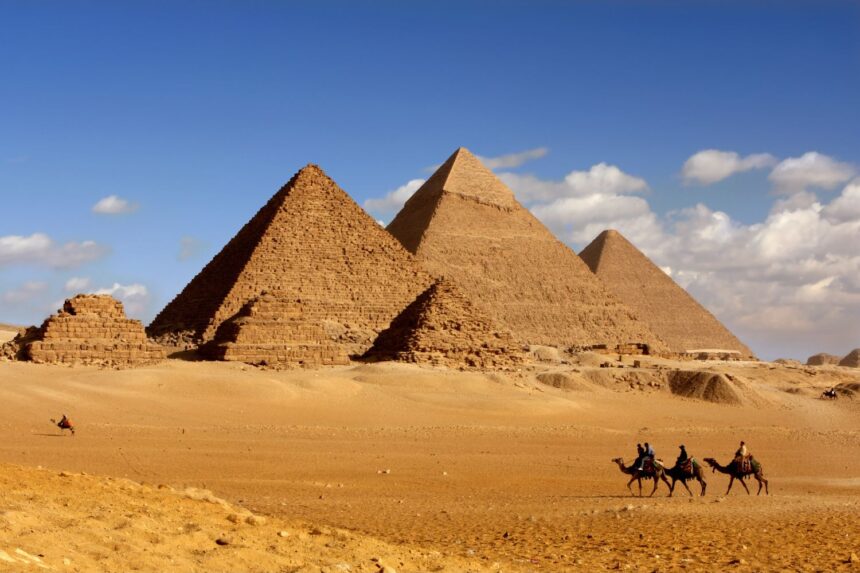A groundbreaking study published this week has ignited debate among archaeologists and historians, suggesting that ancient Egyptians may have employed hydraulic lifts to construct the monumental pyramids, including the Great Pyramid of Giza. This theory, while controversial, proposes a significant advancement in our understanding of the engineering feats achieved by one of history’s most remarkable civilizations.
The research, conducted by a team of engineers and Egyptologists from the University of Cairo and the Massachusetts Institute of Technology (MIT), suggests that the ancient Egyptians harnessed the principles of hydraulics to lift massive stone blocks weighing several tons. According to the study, these hydraulic lifts could have dramatically reduced the labor and time required to erect the pyramids, which have long been attributed to a labor-intensive process using ramps and brute force.
Dr. Ahmed El-Sayed, the lead researcher, explained that ancient texts and hieroglyphs hint at the use of water in construction, but the idea of hydraulic lifts had not been explored in depth until now. “By applying modern engineering principles to ancient methods, we can envision how the Egyptians might have used water pressure to move and position heavy stones with precision,” El-Sayed stated during a press conference.
The study details a theoretical model where water reservoirs would be used to create hydraulic pressure, allowing workers to lift blocks vertically with relative ease. This method would not only save time but also minimize the risk of injury among laborers, challenging the traditional narrative of pyramid construction as an arduous and dangerous task.
However, the research has faced skepticism from some academics. Dr. Sarah Thompson, an archaeologist specializing in ancient Egyptian architecture, expressed her concerns: “While the idea is intriguing, there is currently insufficient evidence to support the existence of such advanced hydraulic technology during the time the pyramids were built. The Egyptians were undoubtedly skilled engineers, but we must be cautious about attributing modern concepts to ancient practices without clear proof.”
The debate has reignited interest in the construction of the pyramids, which have long captivated the imagination of scholars and the public alike. Despite the controversy, the study has garnered attention and sparked discussions on the ingenuity of the ancient Egyptians.
As the academic community continues to ponder the implications of this research, one thing remains clear: the legacy of the pyramids is far from fully understood. With ongoing excavations and advancements in technology, new discoveries may soon shed light on the methods that allowed this ancient civilization to achieve architectural wonders that have stood the test of time.
The study has been published in the *Journal of Ancient Engineering* and is expected to be a focal point of discussion at the upcoming International Symposium on Egyptian Architecture.
Ancient civilisations and their engineering
Ancient civilizations employed a variety of innovative engineering techniques in their construction projects, many of which laid the groundwork for modern engineering practices. Here are some notable methods:
1. Arch Construction: The use of arches, developed by the Romans, allowed for the construction of larger and more stable structures, such as aqueducts and bridges. The arch distributes weight more evenly, enabling the creation of expansive open spaces.
2. Post-and-Lintel System: Used by ancient Greeks and Egyptians, this technique involves placing horizontal beams (lintels) across vertical supports (posts) to create doorways, windows, and larger structures like temples.
3. Catenary Arches: Ancient builders recognized that a chain or rope hung freely forms a catenary curve. This principle was applied in the construction of domes and arch structures, allowing for strong and stable designs.
4. Mudbrick Construction: Many ancient civilizations, like the Mesopotamians and Egyptians, used sun-dried mudbricks to build homes and public buildings. This technique was cost-effective and utilized locally available materials.
5. Stone Masonry: Cultures such as the Incas and Egyptians perfected the art of stone masonry, using precisely cut stones that fit together without mortar (as seen in Machu Picchu and the Great Pyramid of Giza). This technique ensured durability and resistance to natural disasters.
6. Vaulting and Domes: The Romans advanced the use of vaults and domes, allowing them to create expansive interior spaces in buildings like the Pantheon. Their understanding of geometric shapes and weight distribution was revolutionary.
7. Water Management Systems: Ancient civilizations, including the Persians and the Indus Valley people, developed sophisticated irrigation systems, aqueducts, and drainage systems to manage water for agriculture and urban areas.
8. Geopolymer Technology: Some researchers suggest that ancient Egyptians may have used early forms of geopolymer technology to create concrete-like materials for construction, allowing for strong and durable structures.
9. Leverage and Simple Machines: Ancient builders utilized simple machines like levers, pulleys, and ramps to move heavy materials. These tools increased efficiency and reduced the manpower required for construction.
10. Alignment and Astronomy: Many ancient structures, including Stonehenge and the pyramids, were aligned with celestial bodies. Builders used astronomical observations to ensure precise orientation and alignment.
These techniques not only showcase the ingenuity of ancient civilisations but also highlight their understanding of materials, physics, and their environment, which continues to influence modern engineering and architecture.
ALSO READ: Chinese and Egyptian experts digitize Egyptian antiquities














Your article helped me a lot, is there any more related content? Thanks!